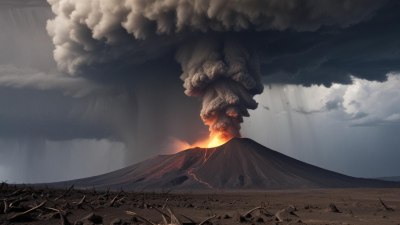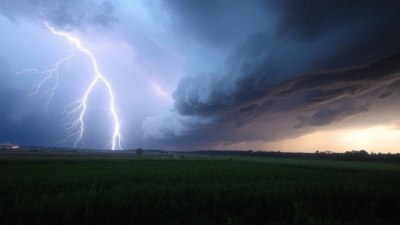Why the Horizon Glows Red and Pink at Certain Times of Year
Discover the science behind the stunning red and pink hues of the horizon during different seasons.

Image by kjpargeter on Freepik
The horizon often displays mesmerizing hues of red and pink, a spectacle that captivates viewers and inspires countless photographs. This remarkable phenomenon occurs particularly during specific times of the year and is primarily influenced by the interplay between sunlight, atmospheric conditions, and seasonal changes. Understanding the science behind these vivid colors not only enriches our appreciation of nature's beauty but also highlights the complex processes that govern our environment.
To comprehend why the horizon glows red and pink, we must first delve into the fundamentals of how light travels through the atmosphere. The colors we see at sunrise and sunset result from a process known as Rayleigh scattering. As sunlight enters the Earth's atmosphere, it interacts with air molecules and particles, scattering the shorter wavelengths of light—blue and violet—more than the longer wavelengths—red and orange. During the day, when the sun is high in the sky, blue light is scattered in all directions, giving the sky its prominent blue hue. However, during sunrise and sunset, when the sun is near the horizon, the sunlight has to travel through a greater depth of the atmosphere.
As the sun lowers into the horizon, its light has to pass through more air, increasing the scattering effect. The blue and violet wavelengths are scattered out of our line of sight, while the reds, oranges, and pinks become more pronounced. This is especially evident in clear skies, where the vibrant colors can often be seen as a gradient transitioning from blue to gold to red. The angle of the sun, combined with the atmospheric conditions, plays a critical role in determining the intensity of these colors.
Seasonal changes significantly impact the occurrence and visibility of red and pink skies. For instance, in many regions, winter months often produce clearer air and more vivid sunsets due to lower humidity. During winter, the cooler temperatures can lead to a more stable atmosphere, reducing the number of particles that might scatter the light in an unfavorable manner. Consequently, viewers in these areas may observe more brilliant red and pink hues as the sun sets.
In contrast, during late summer and early autumn, the atmosphere may contain more moisture and particulates from natural phenomena such as forest fires, dust storms, or pollution. When these particles increase in the atmosphere, they can also scatter longer wavelengths of light, amplifying the reds and pinks seen at dawn and dusk. This results in some of the most breathtaking sunsets, where fiery colors extend across the sky, often accompanied by a magnificent contrast against darkening clouds.
Geographic location also plays a crucial role in the vibrancy of red and pink horizons. Areas closer to the equator often witness more intense colors due to a consistent angle of sunlight throughout the year. Meanwhile, polar regions can experience dramatic changes in light quality and angle during different seasons, resulting in varied sunset colors. Coastal areas, impacted by the vast expanse of the ocean, can also provide formidably beautiful sights when the setting sun casts its light upon the water, creating reflections that enhance the colors of the sky.
Atmospheric conditions such as clouds also significantly affect the colors we observe. While clear skies are ideal for viewing vibrant sunsets, the presence of certain cloud types can enhance the display. For example, cirrus clouds, very high and wispy clouds, can catch sunlight and reflect pink and red hues, creating an ethereal effect. These clouds tend to glow as sunlight hits them at certain angles, producing a stunning contrast with the darker sky below.
Conversely, thick cloud cover can mute or entirely obscure the colors of sunset light. However, sometimes, when the sun dips below the cloud cover, the rays can illuminate the edges of clouds, resulting in spectacular flashes of color. The interplay between the clouds and sunlight can produce a wide array of shades, transforming a typically mundane evening sky into a palette of brilliance.
The role of atmospheric pollutants cannot be understated either. While pollution is detrimental to the environment, it can enhance sunset colors by providing more particles for the light to scatter. This is noted in urban environments, where buildings, factories, and vehicles emit particulates that interact with the light. As a result, city dwellers often find themselves treated to exceptional sunset displays, albeit at the cost of air quality.
Throughout the year, the changing tilt of the Earth’s axis also affects how we perceive sunset colors. During equinoxes, the sun's position in the sky is more directly overhead for many regions, leading to a shift in how light is dispersed in the atmosphere. As winter gives way to spring, and spring transitions to summer, the angles of sunlight and the atmospheric composition shift, resulting in different visual phenomena as the horizon glows in those warmer hues.
In regions farther north, changes in daylight duration also affect the colors observed at sunset. Longer days during summer mean more time for light interaction with the atmosphere. This results in longer-lasting hues as the sun takes longer to dip below the horizon. The gradation of light and colors is typically pronounced, creating stunning visual displays that range from pastel pinks to deep crimson. This is particularly true in areas with a more pronounced auroral activity, where additional natural lights may further enhance the vibrancy of sunset colors.
As we reflect on why the horizon glows red and pink at certain times of the year, it's vital to recognize how this phenomenon serves as a beautiful reminder of how interconnected our natural world is. The combination of scientific principles, seasonal changes, geographic influences, and environmental factors creates a spectacle that is not only visually stunning but also serves as an opportunity for deeper appreciation of the atmospheric sciences at play. So next time you witness a gloriously colored sunset or sunrise, take a moment to appreciate the complex dance between sunlight and the atmosphere that brings such beauty to our skies.











